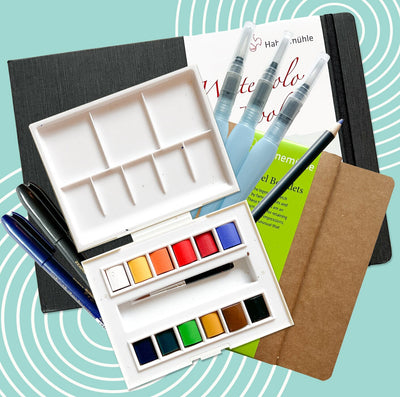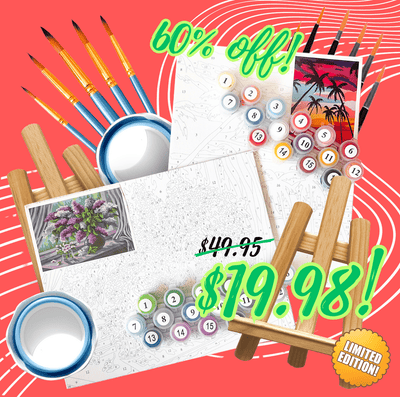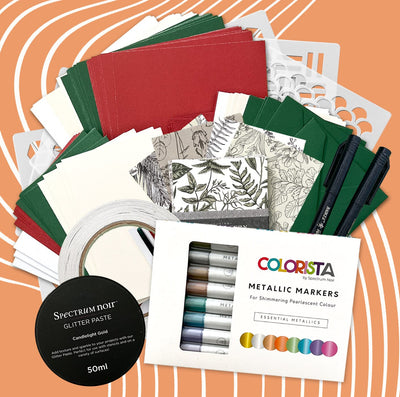Happy Fall Muse Kits Friends!
This month, just in time for the spooky season, we are bringing you a classic medium, pen, and ink perfect for creating seasonal artwork. When the weather starts getting chilly, and you retreat indoors, what could be better than getting out some high-quality paper and creating some stunning ink drawings?
Pen and ink is an ancient medium that started 4500 years ago in Egypt and China. But all these years later, it is still an incredibly popular medium. Nowadays, pen and ink can refer to all kinds of things, from pens with wells, glass dip pens with a bottle of ink, and even colorful brush pens with felt tips. There is so much to work with that this art form feels limitless. I use pens daily, so I wanted to know how this medium came about and how it developed since then, so I did some digging.
In this blog, I will share with you how pen and ink art came to be and go in-depth about the glass dip pens and brush markers you have in your box.
Beginnings of Pen and Ink Drawings
Pen and ink is an ancient medium used for writing and making art for centuries. Both elements developed semi-concurrently but independently, so I want to go into both to discover where this beloved art form began
Pens
The clear origin of pens is not entirely linear because many creations came into existence at a similar point in time but in different locations. There is evidence of brush pens being used in the 1st millennium BCE in China. Quills are referenced in 7th-century European writings, and the Egyptians used thick reeds from 300 BCE. Even though these civilizations weren’t connected at this time, the need to document our experiences and produce art caused them all to innovate a pen-like implement. These implements were dipped into ink and used to write or draw until the ink supply ran out when they would need to re-dip.
A more modern machine-made steel point pen was created by John Mitchell in 1828. The more rudimentary predecessors deteriorated over time and needed to be replaced, so this new innovation solved this issue, though it did increase in price. However, even this invention didn’t do away with the laborious need to dip your pen in the ink continuously.
Fountain pens were the first to combine the steel point with a reservoir of ink held in the pen itself. These reservoirs would deposit the ink directly to the nib without continuously dipping. The ink cartridges could be easily refilled and later replaced using disposable cartridges. This discovery eventually led to the invention of the ballpoint pen in the late 19th century. It became popular in Great Britain in the late 30s and spread across the world from there.
Nowadays, we have many forms of pens that can be used for writing or making art. However, these pens could not work without the ink. So how did that come about?

Ink
Yet again, we have China and Egypt to thank for the creation of ink. The original inks were created with lamp black (soot), which they mixed with glue or gum to create a stick. This was then mixed with water to create a liquid pigment. Colored inks were made using juices or extracts taken from plants, animals, and minerals. An ink made of iron salt and tannin extract is the grandfather of the Indian ink we use today, which is carbon black and water with a stabilizer like gum Arabic.
While we still use some natural extracts as pigments, these days, we also have synthetic pigments to color our inks.
Now that we know where pen and ink started, I want to get into more detail about the tools we’ve provided to inspire you.

Glass Dip Pen
Glass dip pens were invented in 18th-century Italy on the island of Murano, Venice’s home of the glass industry. The artisans creating the pens were treated like noblemen but were not permitted to leave the island without a permit. Despite these constrictive circumstances, the glass blowers were able to create innovatively reusable writing implements that could also be used for art and writing alike.
The glass pens have small grooves set into the tips that act as capillaries to draw up the ink. These grooves can be straight, half-twisted, or twisted. These configurations not only look beautiful, but they also affect the way the ink flows and how much ink it holds onto in one dip.
These pens take us back to our ancestors' traditional dipping methods, but they have become popular again in the last few years. The modern glass dip pens are designed to hold onto a considerable amount of ink, so you won’t be dipping as much as you would with a quill.
To use your glass dip pen, dip it halfway up the nib to allow the ink to fill. Write or draw until the ink runs out before redipping. If you are finished using the open or the ink has clogged the pen, simply swish it in some water and dry it off with a cloth.
Glass dip pens are best suited for writing, linework, cross-hatching, and stippling. The stiff glass tip means that it doesn’t respond to pressure, so you won’t be able to change up your line weight.

Brush Markers
Brushmarkers merge traditional writing brush pens with reservoir pens to create a pen that mimics working with a brush without the need to dip. The tips can be made from felt, natural, or synthetic hair, depending on how flexible the tip is and whether you want individual brush marks. The pen nibs vary in size and flexibility, but most brush pens allow you to change your line weight using pressure.
The nibs absorb the ink from the well inside the plastic casing and deposit it on your paper in a controlled manner. Most top-end alcohol marker brands will offer refills for their pens, which saves you money and prevents waste.
Brush markers can mainly be divided into two types: alcohol-based and water-based. Basically, this just refers to the base that the pigment is carried in. The Spectrum Noir Markers in your box are alcohol-based, so they are perfect for blending together to create layered artwork with a lot of depth. Water-based markers tend to be more affordable, which is why I have such a huge collection, but the one downside to these markers is that they don’t blend together well.
Brush pens are suitable for linework and coloring, depending on what nib size you use.

My favorite way to make pen and ink art is to combine these two mediums to create something dynamic and layered. I use the glass dip pen for all the linework and then fill it in with the brushmakers. Then, to add even more depth, I go back in with the glass dip pen to add texture with crosshatching and stippling.
I hope that this little dive into history has inspired you to make your own incredible pen and ink art with your new supplies. We can’t wait to see what you come up with!




